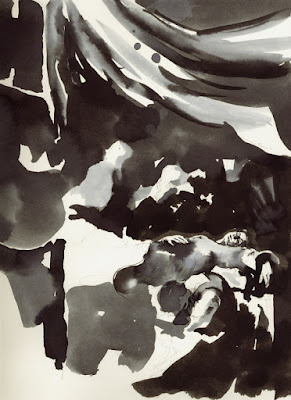Who really invented abstraction? Everyone.
 |
|
A dog engulfed in sand, 1819-1823, Francisco Goya, courtesy of Museo del Prado
|
A thoughtful reader sent me this essay yesterday, which nominates the Swedish painter Hilma af Klint, rather than Wassily Kandinsky, as the first practitioner of abstract art. Like Kandinsky, she was a follower of Madame Helena Blavatsky, occultist, spirit medium, and founder of Theosophy. Like Kandinsky, she believed her abstract paintings were, in fact, representations of spiritual ideas.
When I studied art back in the last millennium, the first abstract painting was attributed to the great Spanish romantic, Francisco Goya. The painting in question, now called A Dog Engulfed in Sand, or simply El Perro, was one of Goya’s so called ‘black paintings,’ from the end of his life. These are haunted works, reflecting Goya’s bitter disillusionment and fears. He had lived through the terrible Napoleonic Wars and their political aftermath in Spain. He was elderly, nearly deaf, and had survived two brushes with death.
 |
|
Seascape Study with Rain Cloud (Rainstorm over the Sea), 1824-28, John Constable, courtesy Royal Academy of Arts
|
Goya never intended El Perro or any of the other black paintings to be shown. By the 20th century, however, El Perro was famous. Pablo Picasso certainly knew it. Antonio Saura called it “the most beautiful picture in the world”. Rafael Canogar described it as the first symbolist painting of the West. The sculptor Pablo Serrano paid homage to it.
 |
|
A study in pencil, ink, ink wash, brush and pen, for The Death of the Virgin, 1601-1606, Caravaggio
|
“The sleep of reason begets monsters,” wrote Goya about Los Caprichos. By the end of his life, the monsters were visiting him during the daytime, too.
Any meaning we ascribe to A Dog Engulfed in Sand comes from its title. That was added later, by art historians. None of the black paintings were titled. They were intensely private, painted as murals on his walls. And what a happy home that must have been.
 |
|
The Monk by the Sea, c. 1808–1809, Caspar David Friedrich
|
At first sight, El Perro doesn’t seem to be a figurative painting at all. Two dominant blocks of color intersect. At that point a blob of grey paint, the face of a dog, represents all of Goya’s anguished humanity. We, the viewers, are being squashed between relentless forces.
“Abstraction” is a word Goya would not have understood, let alone used. But it is abstraction that gives El Perro its awful power.
 |
|
Mountain market, clearing mist, Yu Jian, Song Dynasty, China
|
Many early artists used raw abstraction to work out ideas, or just to doodle, just as figurative painters still do today. I’ve included a few famous examples here, ranging from Caravaggio to Caspar David Friedrich. And that’s just in the western canon. In eastern art, the idea of the voidmeant that slavish adherence to representation was never a paramount virtue.
